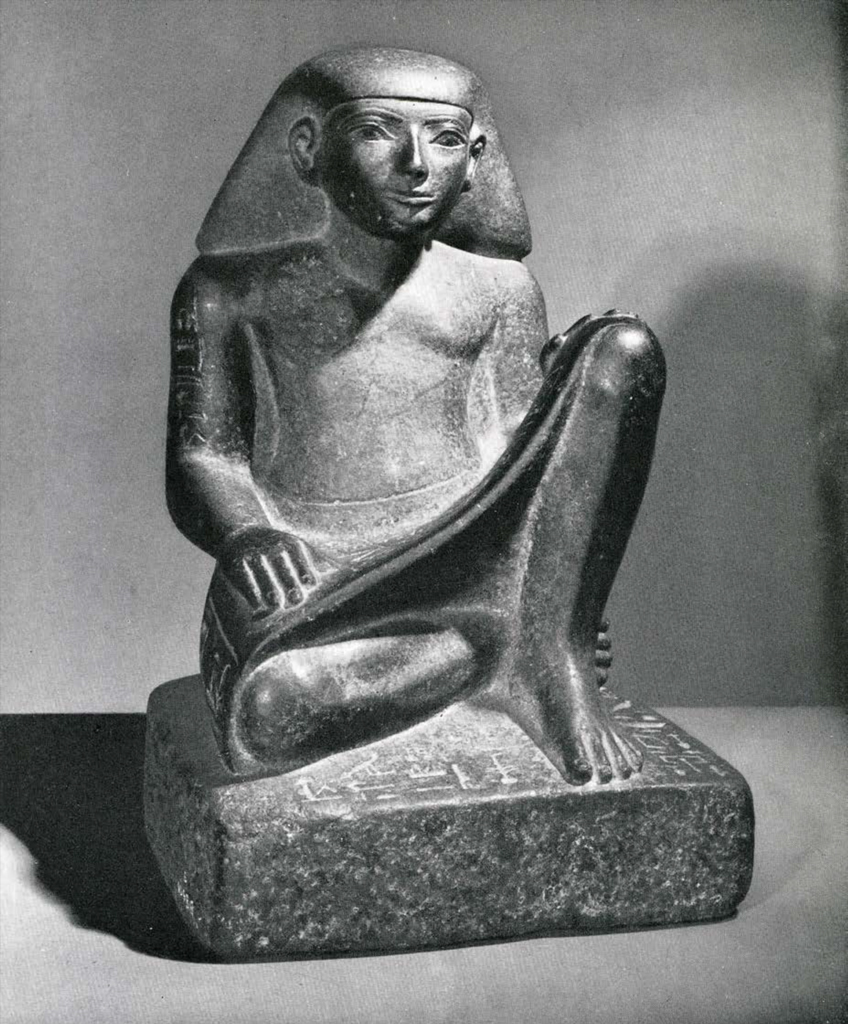THE Eckley B. Coxe Expedition of 1909 to Buhen in Nubia found a beautiful dark diorite1 statuette of a man by the name of Amenemhet (Plate IX).2 The style of the statuette, as well as of its hieroglyphic inscriptions leave no doubt that it belongs to the early part of the 18th dynasty. The man, who calls himself a “royal scribe,” is shown seated on the ground, his left knee raised. A papyrus is spread out on his lap, its left end held by Amenemhet’s left hand. But he has finished writing. His right hand is stretched out, palm down, on the papyrus roll.

Museum Object Number: E10980
Image Number: 23177, 32263
There are several aspects which give this statuette a special interest. To the rarity of its type3 and to its excellent artistic workmanship, attention has been drawn by the finder, Mr. D. Randall-MacIver, in a former issue of the Museum Journal.4 I want here to emphasize the unusual situation in which it was discovered, and which calls for an explanation. It was neither found in one of the temples, which would seem an appropriate place for such a statuette, nor in the ruins of one of the numerous 18th dynasty houses which were excavated at Buhen but, as the report says, “in the most improbable of places,” close to the northern wall of the “inner city” in the drifted sand of the desert only three feet below the surface. It was buried there together with two other early 18th dynasty statuettes, one of them representing the same scribe Amenemhet. When trying to explain this strange fact, the excavators assumed that the statuettes had been carried away, probably by robbers, “from their original place and dropped or deposited where we found them.” That the statuettes had been removed from their original places is certain but what interest would “robbers” have had in removing them? And still more surprising, in burying them carefully in the sand? It must be mentioned in this connection, that all three of the statuettes were found in a perfect state of preservation.
I want to suggest a different explanation which, I think, is corroborated by another most surprising fact. In the same expedition the tombstone of this same Amenemhet was found, again in one of the most improbable places, and in addition to that, in a most unexpected condition. The stone5 was not found in a cemetery but in the precincts of a private house of the 18th dynasty. Its corners were carefully cut off and rounded, so as to form the base of a column.
How can these two remarkable facts be combined to give a reasonable explanation?
As the inscriptions show, Amenemhet was in some way employed by Queen Hatshepsut, whose partisans, as we know, were most cruelly persecuted after the queen’s death. Might not the following hypothesis be permitted? Amenemhet, who had set up, according to custom, his statues in the temple of Horus that he might be near his god forever, had died before Hatsheput, and his tombstone had been erected in the local cemetery. But when the news of the great queen’s death reached Buhen, his statuettes and his tombstone met with remarkably different fates. The tombstone was torn out of its place in the cemetery by one of Amenemhet’s personal enemies, who was just building himself a new home, and who used the mutilated stone to carry, through all his life at least, the weight of the column supporting the roof of his house.6 The statuettes, however, were saved. A friend of the pious deceased, perhaps one of the priests of Horus, succeeded in rescuing them from the temple in time and buried them as closely as possible to the sanctuary, trusting that at least some of the benefits which Amenemhet had hoped for when he erected his statuettes in the temple, would, after all, fall to his lot.
H. R.
1 More accurately “diabase,” an igneous intrusive rock. ↪
2 Catalogue Number E 10980. The height is 0.37 m., the width of the base 0.23 m. Two other views of the statuette have been published by D. Randall-MacIver andC. L. Wooley, in their volume on Buhen, pl. 36. ↪
3 A rather similar type, of the 6th dynasty, was found by Professor Junker at Giza. ↪
4 Volume I, No. 2 (1910), p. 27 ff. and fig. 15. ↪
5 Buhen, pl. 34 (No. 10982). It is now in the Museum at Khartum. ↪
6 The idea would be comparable to the fate of that prisoner, crushed beneath the door hinge of the temple of Hierakonpolis, whose uncanny figure forms one of the treasures of our Egyptian collection, cf. Gunn, Museum Bulletin, vol. 5, No. 1. p. 9 ff. ↪

